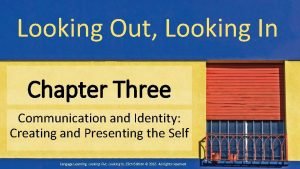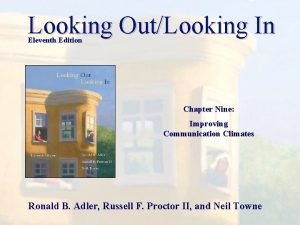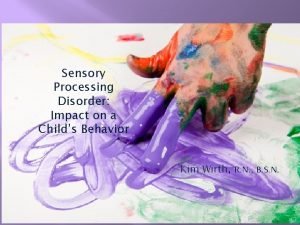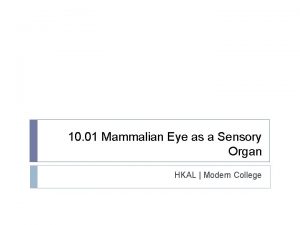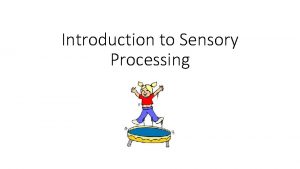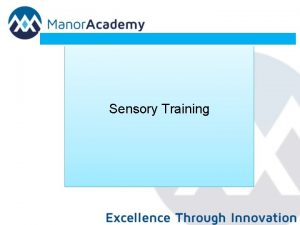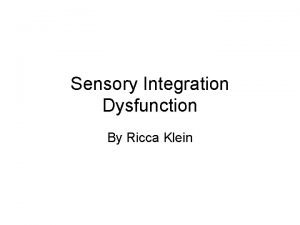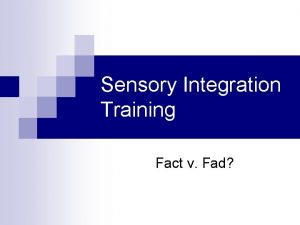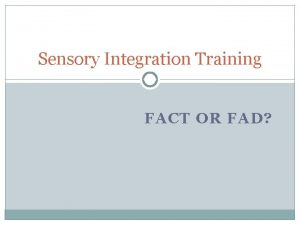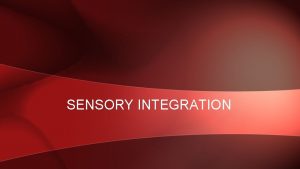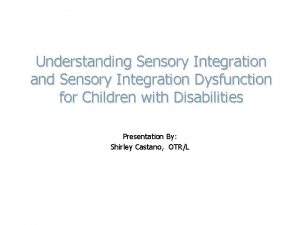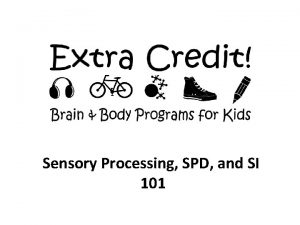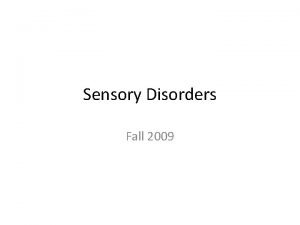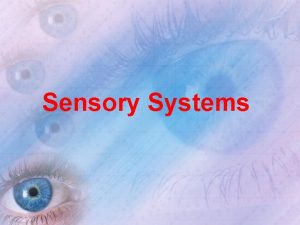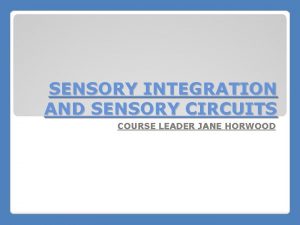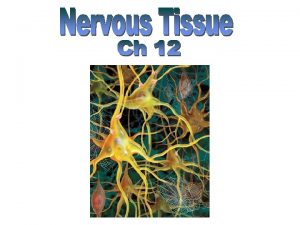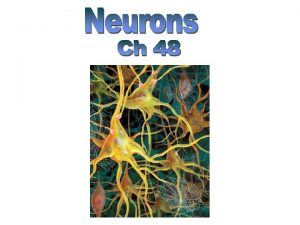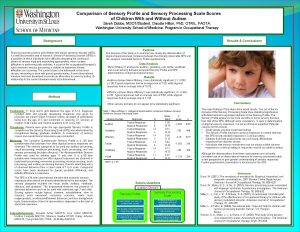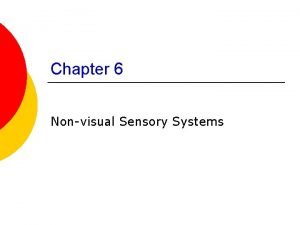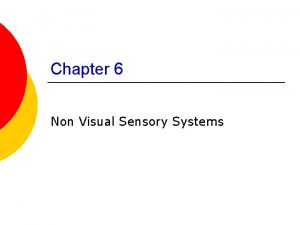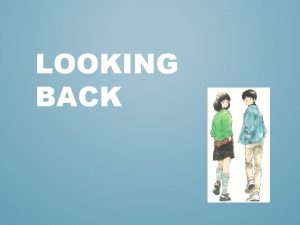Sensory Processing Integration Looking for a new insight













![Abraham Maslow 1908 - 1970 “all needs are instinctive, [but] some are more powerful Abraham Maslow 1908 - 1970 “all needs are instinctive, [but] some are more powerful](https://slidetodoc.com/presentation_image_h2/5cdd6f0702703d61680e8486e48d2a83/image-14.jpg)





















































- Slides: 67


Sensory Processing & Integration Looking for a new insight

Introduction • “What happens to a sense? ” a history of Psychology • Introduction of Sensory Integration WORKSHOPS • Brain Systems and Sensory Roles • A New View of Sensory Systems • How can it affect the children we see?

What Happens to a Sense? A journey back through time.

The Behaviourists 1890’s All human endeavour can be explained as behaviour.

Pavlov and his dogs 1848 -1936 ' Only one thing in life is of actual interest to us - our physical experience. Its mechanism, however, has been, and remains, wrapped in a deep mystery '

Pavlov and his dogs 1848 -1936

Stimulus Reception Attention Function/Performance

The Cognitive Psychologists 1950’s I think therefore I am

Aaron T Beck 1921 - date “Dr. Beck established for the first time the efficacy of any psychotherapy for the treatment of depression. ”

What Happens to a Sense? Stimulus Reception Attention Function/Performance

What Happens to a Sense? Stimulus Reception Attention Awareness Memory Focus Function/Performance

The Humanists 1960’s I am therefore I develop
![Abraham Maslow 1908 1970 all needs are instinctive but some are more powerful Abraham Maslow 1908 - 1970 “all needs are instinctive, [but] some are more powerful](https://slidetodoc.com/presentation_image_h2/5cdd6f0702703d61680e8486e48d2a83/image-14.jpg)
Abraham Maslow 1908 - 1970 “all needs are instinctive, [but] some are more powerful than others”

Hierarchy of Human Needs “The lower the need is in the hierarchy the more powerful it is. ”

What Happens to a Sense? Stimulus Reception Attention Awareness Memory Focus Function/Performance

Sensory Integration Theory Sensation underlies all behaviour and thinking.

Jean Ayres 1920 - 1988 Believed that without understanding sensory systems our understanding of children’s development was flawed.

Sensation in the Human System Informs all subsequent Neurological Processing And thereby behaviour. Cognitive Perceptual Motor inc. Speech Sensory Pathways The Environment

What Happens to a Sense? Stimulus Reception Amplification/Modulation Integration Awareness Memory Attention Focus Function/Performance

What Happens to a Sense? Stimulus Reception Amplification/Modulation Integration Awareness Memory Attention Focus Function/Performance

What Happens to a Sense? Stimulus Reception Amplification/Modulation Integration Awareness Memory Attention Focus Function/Performance

WORKSHOPS

Arousal, Performance & Sensation Performance Too Low AROUSAL Too High Evidence increasingly suggests that this is an inter-relationship. Some Sensory Systems may drive or lower Arousal. Correct Arousal States may influence successful Modulation

Modulation and Registration • Thresholds are set so that registration attention occur when appropriate in our environment. No Transmission Neural Stream Sensory Threshold

Modulation and Registration • Thresholds are set so that registration attention occur when appropriate in our environment. Transmission Neural Stream Sensory Threshold

Modulation and Registration • Thresholds are set so that registration attention occur when appropriate in our environment. Transmission Blocked Neural Stream Sensory Threshold High

Modulation and Registration • Thresholds are set so that registration attention occur when appropriate in our environment. Transmission exceeds acceptable Level Neural Stream Sensory Threshold Low

Sensory Processing Pathways & Modulation • • • Tactile/Proprioceptive Vestibular Visual Auditory Olfactory/Oral Fnx PRISM

Sensory Processing causing avoidant behaviours • • • Tactile/Proprioceptive Vestibular Visual Auditory Fnx Olfactory/Oral PRISM

Sensory Information causing extreme distress behaviours • • • Tactile/Proprioceptive Vestibular Visual Auditory Fnx Olfactory/Oral PRISM

Sensory Processing causing seeking behaviours • • • Tactile/Proprioceptive Vestibular Visual Auditory Olfactory/Oral Fnx PRISM

Sensory Processing causing substitute behaviours • • • Tactile/Proprioceptive Vestibular Visual Auditory Fnx Olfactory/Oral PRISM

BRAIN SYSTEMS

Thinking Patterning Cognitive Spatial/Attentional/ Postural Control Attentional Systems Arousing Laurie Lundy-Ekman (2007) Neuroscience Fundamentals for Rehabilitation Chapter 13, P. 356



Body State Arousal System

Body State/ Arousal System Tactile/Auditory/ Intrareception Inputs

Body State Arousal System • • • Can Amplify signals. Has Strong arousal consequences Supplied by tactile sensory pathways. Is linked to pain systems Processes interaception, and affects arousal by this route also.

Attentional System

Attentional Systems Visual/Auditory/ Proprioceptive and Vestibular inputs Body State/ Arousal System Tactile/Auditory/ Intrareception Inputs

Provides Occculomotor Control & Develops Depth Perceptions Proprioceptive Visual Vestibular Provides Gaze stabilisation during movement Provides Head and Neck Control

Proprioceptive Auditory Vestibular

Auditory Visual Vestibular Proprioceptive

Auditory Visual Vestibular Proprioceptive

Auditory Visual Vestibular Proprioceptive

Visual Auditory Vestibular Proprioceptive

Visual Auditory Vestibular Proprioceptive

Visual Auditory Vestibular Proprioceptive

Visual Auditory Vestibular Proprioceptive

Visual Auditory Vestibular Proprioceptive

Visual Auditory Vestibular Proprioceptive

Attentional System • • Very dynamic High levels of sensory integration Sensory systems vital for calibration Opens up the concept of bodyscheme - Bodyscheme exists where proprioception integrates with another sense • Slow to develop but fast once established • Has to perform well during high arousal

Memory / Patterning and Cognitve Systems

Patterning Memory Situational Memory Multisensory Complex Arousal Dependant Formed by feeds from Attentional and Patterning Systems and Arousal Dependant Attentional Systems Visual/Auditory/ Proprioceptive and Vestibular inputs Body State/ Arousal System Tactile/Auditory/ Intrareception Inputs

Memory / Patterning and Cognitve Systems • Slower but more sophisticated processing • Need optimum arousal to work • Act to direct attentional systems on the basis of previous experiences

Patterning Memory Situational Memory Multisensory Complex Arousal Dependant Formed by feeds from Attentional and Patterning Systems and Arousal Dependant Attentional Systems Visual/Auditory/ Proprioceptive and Vestibular inputs Body State/ Arousal System Tactile/Auditory/ Intrareception Inputs

Memory / Patterning and Cognitve Systems • Slower but more sophisticated processing • Need optimum arousal to work • Act to direct attentional systems on the basis of previous experiences • Are dependant on good quality sensory systems to achieve good pattern recognition • Tag emotions to experiences

Sensory Processing/Modulation/Learning Model P e r f o r m a n c e Memory laydown Memory Recall and comparison Attentional System Co g ni tv e. S ys tem A r o u s a l

Sensory Integration as a Developing Continuum • Behaviour is Sensory Integration that has occurred. • Development is Sensory Integration that is or will occur. TIME Behaviour Development

Sensory Integration as a Continuum • Behaviour is Sensory Integration that has occurred. • Development is Sensory Integration that is or will occur. TIME Behaviour Development

Sensory Integrative Dysfunction and the Medical Model Sensory Integration may play part in, or being the result of, a variety of clinical Presentations. Autistic Spectrum Disorders Dyspraxia ADD/ADHD Global Developmental Delay Learning Disabilities Cerebral Palsy It is not currently considered a diagnosis. It does have it’s own unique expressions that may be more meaningful than an overall.

Sensory Integration and School • Extreme behaviour may be signalling a developmental need, or a sensitivity. • Meeting sensory needs prior to a learning experience may improve skills acquisition. • Influencing arousal levels correctly will improve learning. • Development occurs best, when problem behaviours have been diffused or channeled.

Sensory Integration and Families • A child with difficulties may present from normal to having a “heavy” diagnosis. • A child with difficulties may be identified as having behavioural issues and often does. • The contract of play in the family may be significantly skewed. • Parents can’t look to other children and families for advice and inspiration, because it doesn’t work for their child.

Sensory Integration as Treatment • As an Insight, for advice and guidance. • As the baseline for adapting a child’s sensory environment. • As a strategy for achieving behavioural outcomes. • As the baseline for launching a Sensory Integration developmental intervention. • As an adjunct to play therapy and understanding family dynamics.

Any Questions?
 Looking out looking in summary
Looking out looking in summary Looking out looking in chapter 9
Looking out looking in chapter 9 Interventricular foramen
Interventricular foramen Sensory processing disorder dsm
Sensory processing disorder dsm Sensory processing disorder dsm
Sensory processing disorder dsm Sequence of sensory processing
Sequence of sensory processing Ogenus offshore
Ogenus offshore Forward integration and backward integration
Forward integration and backward integration Make or buy continuum
Make or buy continuum What is simultaneous integration
What is simultaneous integration Bottom up vs top down processing
Bottom up vs top down processing Gloria suarez
Gloria suarez Bottom up and top down processing
Bottom up and top down processing Neighborhood averaging in image processing
Neighborhood averaging in image processing What is secondary processing of food
What is secondary processing of food What is point processing in digital image processing
What is point processing in digital image processing Histogram processing in digital image processing
Histogram processing in digital image processing Parallel processing vs concurrent processing
Parallel processing vs concurrent processing Laplacian filter
Laplacian filter Point processing in image processing
Point processing in image processing Thinning and thickening in image processing example
Thinning and thickening in image processing example Bottom up vs top down processing
Bottom up vs top down processing Batch processing and interactive processing
Batch processing and interactive processing Fspos
Fspos Novell typiska drag
Novell typiska drag Nationell inriktning för artificiell intelligens
Nationell inriktning för artificiell intelligens Returpilarna
Returpilarna Varför kallas perioden 1918-1939 för mellankrigstiden
Varför kallas perioden 1918-1939 för mellankrigstiden En lathund för arbete med kontinuitetshantering
En lathund för arbete med kontinuitetshantering Underlag för särskild löneskatt på pensionskostnader
Underlag för särskild löneskatt på pensionskostnader Tidbok yrkesförare
Tidbok yrkesförare Sura för anatom
Sura för anatom Densitet vatten
Densitet vatten Datorkunskap för nybörjare
Datorkunskap för nybörjare Stig kerman
Stig kerman Hur skriver man en tes
Hur skriver man en tes Autokratiskt ledarskap
Autokratiskt ledarskap Nyckelkompetenser för livslångt lärande
Nyckelkompetenser för livslångt lärande Påbyggnader för flakfordon
Påbyggnader för flakfordon Lufttryck formel
Lufttryck formel Svenskt ramverk för digital samverkan
Svenskt ramverk för digital samverkan Kyssande vind
Kyssande vind Presentera för publik crossboss
Presentera för publik crossboss Teckenspråk minoritetsspråk argument
Teckenspråk minoritetsspråk argument Vem räknas som jude
Vem räknas som jude Treserva lathund
Treserva lathund Fimbrietratt
Fimbrietratt Claes martinsson
Claes martinsson Cks
Cks Lågenergihus nyproduktion
Lågenergihus nyproduktion Mat för unga idrottare
Mat för unga idrottare Verktyg för automatisering av utbetalningar
Verktyg för automatisering av utbetalningar Rutin för avvikelsehantering
Rutin för avvikelsehantering Smärtskolan kunskap för livet
Smärtskolan kunskap för livet Ministerstyre för och nackdelar
Ministerstyre för och nackdelar Tack för att ni har lyssnat
Tack för att ni har lyssnat Referat mall
Referat mall Redogör för vad psykologi är
Redogör för vad psykologi är Stål för stötfångarsystem
Stål för stötfångarsystem Tack för att ni har lyssnat
Tack för att ni har lyssnat Borra hål för knoppar
Borra hål för knoppar Orubbliga rättigheter
Orubbliga rättigheter Formel för standardavvikelse
Formel för standardavvikelse Tack för att ni har lyssnat
Tack för att ni har lyssnat Steg för steg rita
Steg för steg rita Ledningssystem för verksamhetsinformation
Ledningssystem för verksamhetsinformation Tobinskatten för och nackdelar
Tobinskatten för och nackdelar Blomman för dagen drog
Blomman för dagen drog
